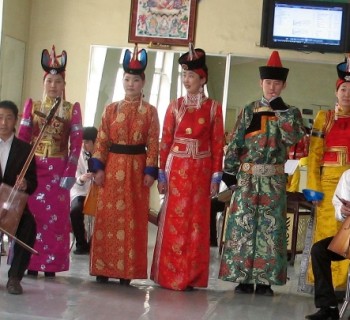Mongolia flag

The national flag of Mongolia was officially approved in 1992. The national symbol has become an integral attribute of statehood along with the country's anthem and emblem.
Description and proportions of the flag of Mongolia
The flag of Mongolia is a rectangle with a length to width ratio of 3: 2. There are three colors on the flag of Mongolia - red, blue and yellow. The flag field is vertically divided into three equal parts. The adjacent to the shaft and the outer part are in red, and the middle one is in dark blue. The national symbol of the country, called Soyombo, is inscribed on a red field near the flagpole..
This emblem was popularized in the country back in the 17th century and has been perceived since then as the main symbol of the unity of the Mongolian people..
The upper part of Soyombo is a fire sign, signifying rebirth and dawn for the peoples of Mongolia. The three flames are the past, present and future, inextricably linked by the history of the Mongol state. The Moon and the Sun are inscribed below, reminiscent of eternity and light. In the center there are fish that do not close their eyes and serve as symbols of vigilance and caution.
Soyombo triangles are the fighting symbols of Mongol warriors, warning external and internal enemies of their valor. Vertical rectangles resemble fortress walls and tell about the famous Mongolian wisdom about the power of friendship.
The gold with which the emblem is applied is interpreted in Mongolia as a symbol of constancy and immutability, and in general Soyomba personifies the desire of the country's inhabitants for freedom and independence..
The red color of the Mongolian flag emphasizes the significance of the victory of the national liberation revolution and symbolizes the hot flame of Mongolian bonfires in the steppe. The blue field is a tribute to the cloudless Mongolian sky, under which hundreds of generations of brave warriors and peaceful herders grew up.
History of the flag of Mongolia
The first flag of Mongolia after the victory of the revolution was a red cloth with the moon and the sun depicted on it. These celestial bodies serve as symbols of celestial parents for the Mongols. Then the Soyombo emblem appeared in blue on the flag field. She rested on a plinth of lotus flowers, thereby emphasizing the inviolability of the foundations of Buddhism in the country..
Then a five-pointed star rose over the symbol on the flag, which was interpreted both as a sign of victorious socialism, and as a guiding Polar, invariably protecting wanderers and travelers.


